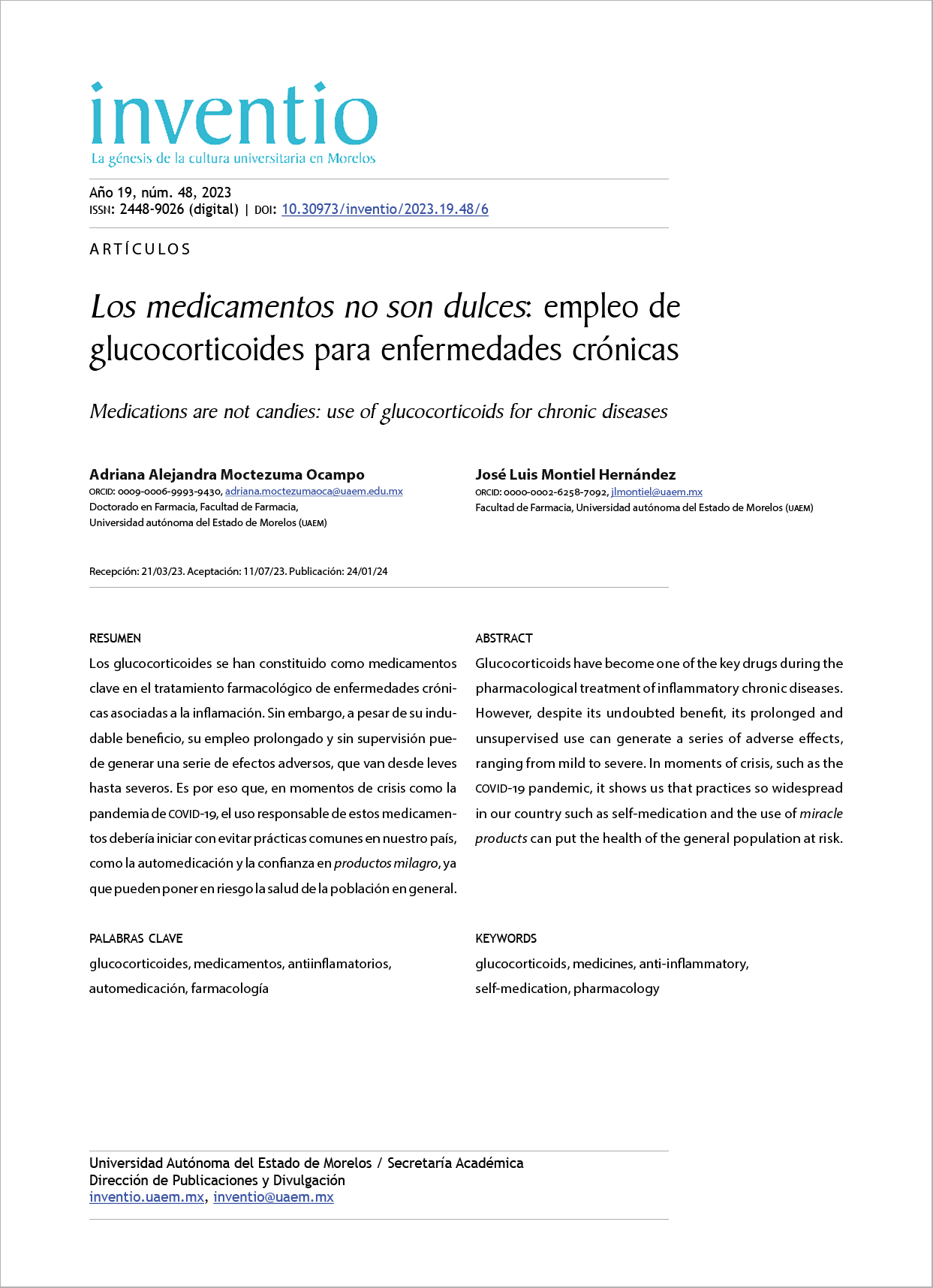Los medicamentos no son dulces: empleo de glucocorticoides para enfermedades crónicas
DOI:
https://doi.org/10.30973/inventio/2023.19.48/6Palabras clave:
glucocorticoides, medicamentos, antiinflamatorios, automedicación, farmacologíaResumen
Los glucocorticoides se han constituido como medicamentos clave en el tratamiento farmacológico de enfermedades crónicas asociadas a la inflamación. Sin embargo, a pesar de su indudable beneficio, su empleo prolongado y sin supervisión puede generar una serie de efectos adversos, que van desde leves hasta severos. Es por eso que, en momentos de crisis como la pandemia de COVID-19, el uso responsable de estos medicamentos debería iniciar con evitar prácticas comunes en nuestro país, como la automedicación y la confianza en productos milagro, ya que pueden poner en riesgo la salud de la población en general.
Citas
Adcock, I. M. y Mumby, S. (2017). Glucocorticoids. Handb Exp Pharmacol, 237, 171-196. http://doi.org/10.1007/164_2016_98
Alessi, J., de Oliveira, G. B., Schaan, B. D. y Telo, G. H. (2020). Dexamethasone in the era of COVID-19: friend or foe? An essay on the effects of dexamethasone and the potential risks of its inadvertent use in patients with diabetes. Diabetol Metab Syndr, 12, 80. https://doi.org/10.1186/s13098-020-00583-7
Alten, R. y Wiebe, E. (2015). Hypothalamic-pituitary-adrenal axis function in patients with rheumatoid arthritis treated with different glucocorticoid approaches. Neuroimmunomodulation, 22(1-2), 83-88. http://doi.org/10.1159/000362731
Baracaldo-Santamaria, D., Trujillo-Moreno, M. J., Perez-Acosta, A. M., Feliciano-Alfonso, J. E., Calderon-Ospina, C. A. y Soler, F. (2022). Definition of self-medication: a scoping review. Ther Adv Drug Saf, 13, 20420986221127501. http://doi.org/10.1177/20420986221127501
Buttgereit, F., da Silva, J. A., Boers, M., Burmester, G. R., Cutolo, M., Jacobs, J., Kirwan, J., Köhler, L., van Riel, P., Visher, T. y Bijlsma, J. W. (2002). Standardised nomenclature for glucocorticoid dosages and glucocorticoid treatment regimens: current questions and tentative answers in rheumatology. Ann Rheum Dis, 61(8), 718-722. http://doi.org/10.1136/ard.61.8.718
Cain, D. W. y Cidlowski, J. A. (2017). Immune regulation by glucocorticoids. Nat Rev Immunol, 17(4), 233-247. http://doi.org/10.1038/nri.2017.1
Comisión Federal para la Protección de Riesgos Sanitarios (2021a). Alerta sanitaria de suplementos alimenticios. Gobierno de México, COFEPRIS. https://www.gob.mx/cms/uploads/attachment/file/247147/Alerta_Sanitaria_GLUCOAJO_C2_09082017.pdf
Comisión Federal para la Protección de Riesgos Sanitarios (2021b). Alerta sobre comercialización ilegal del producto “Artri Ajo King”. Gobierno de México/COFEPRIS. https://www.gob.mx/cofepris/articulos/cofepris-alerta-sobre-comercializacion-ilegal-del-producto-artri-ajo-king-el-cual-no-cuenta-con-registro-sanitario?idiom=es
Coutinho, A. E. y Chapman, K. E. (2011). The anti-inflammatory and immunosuppressive effects of glucocorticoids, recent developments and mechanistic insights. Mol Cell Endocrinol, 335(1), 2-13. http://doi.org/10.1016/j.mce.2010.04.005
Dickmeis, T. (2009). Glucocorticoids and the circadian clock. J Endocrinol, 200(1), 3-22. http://doi.org/10.1677/JOE-08-0415
Fu, J., Cuppen, B. V., Welsing, P. M., van Wietmarschen, H., Harms, A. C., Berger, R., Koval, S., Fritsch-Stork, R. D. E., Bijlsma, J. W. J., Hankemeier, T., van der Greef, J. y Lafeber, F. P. J. G. (2016). Differences between serum polar lipid profiles of male and female rheumatoid arthritis patients in response to glucocorticoid treatment. Inflammopharmacology, 24(6), 397-402. http://doi.org/10.1007/s10787-016-0284-1
Grossman, J. M., Gordon, R., Ranganath, V. K., Deal, C., Caplan, L., Chen, W., Curtis, J., R., Furst, D. E., McMahon, M., Patkar, N. M., Volkmann, E., Saag, K. G. (2010). American College of Rheumatology 2010 recommendations for the prevention and treatment of glucocorticoid-induced osteoporosis. Arthritis Care Res (Hoboken), 62(11), 1515-1526. http://doi.org/10.1002/acr.20295
Hoes, J. N., van der Goes, M. C., Jacobs, J. W., Lafeber, F. P., Bijlsma, J. W. y Van Roon, J. A. (2011). Changes in macrophage inhibitory factor correlate with changes in bone mineral density in glucocorticoid-treated patients with rheumatoid arthritis. Rheumatology (Oxford), 50(10), 1921-1924. http://doi.org/10.1093/rheumatology/ker268
Huscher, D., Thiele, K., Gromnica-Ihle, E., Hein, G., Demary, W., Dreher, R., Zink, A. y Buttgereit, F. (2009). Dose-related patterns of glucocorticoid-induced side effects. Ann Rheum Dis, 68(7), 1119-1124. http://doi.org/10.1136/ard.2008.092163
Muñetón-Pérez, P. (2009). Plantas medicinales: un complemento vital para la salud de los mexicanos. Entrevista con el Mtro. Erick Estrada Lugo. Revista Digital Universitaria, 10(9). https://www.revista.unam.mx/vol.10/num9/art58/art58.pdf
Naranjo, A., Sokka, T., Descalzo, M. A., Calvo-Alen, J., Horslev-Petersen, K., Luukkainen, R. K., Bernard Combe, B., Burmester, G. R., Devlin, J., Ferraccioli, G., Morelli, A., Hoekstra, M., Majdan, M., Sadkiewicz, S., Belmonte, M., Holmqvist, A.-C., Choy, E., Tunc, R., Dimic, A., … The QUEST-RA Group (2008). Cardiovascular disease in patients with rheumatoid arthritis: results from the QUEST-RA study. Arthritis Res Ther, 10(2), R30. http://doi.org/10.1186/ar2383
Park, Y. B., Ahn, C. W., Choi, H. K., Lee, S. H., In, B. H., Lee, H. C., Nam, C. M. y Soo-Kon Lee (2002). Atherosclerosis in rheumatoid arthritis: morphologic evidence obtained by carotid ultrasound. Arthritis Rheum, 46(7), 1714-1719. http://doi.org/10.1002/art.10359
Reichardt, S. D., Amouret, A., Muzzi, C., Vettorazzi, S., Tuckermann, J. P., Luhder, F. y Reichardt, H. M. (2021). The Role of Glucocorticoids in Inflammatory Diseases. Cells, 10(11). http://doi.org/10.3390/cells10112921
Shrestha, A. B., Aryal, M., Magar, J. R., Shrestha, S., Hossainy, L. y Rimti, F. H. (2022). The scenario of self-medication practices during the COVID-19 pandemic; a systematic review. Ann Med Surg (Lond), 82, 104482. http://doi.org/10.1016/j.amsu.2022.104482
Timmermans, S., Souffriau, J. y Libert, C. (2019). A General Introduction to Glucocorticoid Biology. Front Immunol, 10, 1545. http://doi.org/10.3389/fimmu.2019.01545
Weinstein, R. S. (2011). Clinical practice. Glucocorticoid-induced bone disease. N Engl J Med, 365(1), 62-70. http://doi.org/10.1056/NEJMcp1012926
Weinstein, R. S., Nicholas, R. W. y Manolagas, S. C. (2000). Apoptosis of osteocytes in glucocorticoid-induced osteonecrosis of the hip. J Clin Endocrinol Metab, 85(8), 2907-2912. http://doi.org/10.1210/jcem.85.8.6714
Wilson, J. C., Sarsour, K., Gale, S., Petho-Schramm, A., Jick, S. S. y Meier, C. R. (2019). Incidence and Risk of Glucocorticoid-Associated Adverse Effects in Patients With Rheumatoid Arthritis. Arthritis Care Res (Hoboken), 71(4), 498-511. http://doi.org/10.1002/acr.23611

Publicado
Cómo citar
Número
Sección
Licencia
Derechos de autor 2005 Adriana Alejandra Moctezuma Ocampo, José Luis Montiel Hernández

Esta obra está bajo una licencia internacional Creative Commons Atribución-NoComercial 4.0.
Esta revista proporciona acceso abierto inmediato a su contenido, con base en el principio de ofrecer al público un acceso libre a las investigaciones para contribuir a un mayor intercambio global de conocimientos. Se distribuye bajo una licencia Creative Commons Reconocimiento-NoComercial 4.0 Internacional License.

